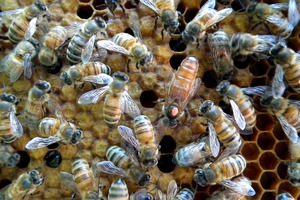The Queen Bee

ln-prehistoric times, as in “primitive" bee societies, today, the honeybee queen was not much different from the other females in the colony — the workers. Among other things, she also collected nectar and pollen. Over millions of years the queen bee’s activities have not changed until today she has only one job to lay the eggs from which all the other bees of the hive develop.
A honeybee queen today not only has a different job from the workers, she, also has different structures that suit her to her job. For example, she has a much larger body which allows her to hold many eggs. She is also able to release different odors that influence worker bee activity. The queen is also
different from the workers because she does not have pollen baskets. She never collects food and depends on the workers to feed her. She does not have wax glands and therefore cannot produce wax or build comb. The queens-does not carry out any of the other task’s worker bees do either. She is too heavy to fly when she is producing and laying eggs. Her worker size wings are too small. There are, in fact, only two times in the life of the queen when she flies. When the queen is between 7 and 10 days old, she makes her first flight. This is her mating flight. A queen will also fly when she leaves the nest with other workers to find a new nest site. Before this flight, she stops laying eggs and her body shrinks, or reduces to worker size.
Queen bees usually live one or two years which is long compared to the life of a worker bee, which is 6 weeks in the summer and 6 months in the winter.
Normally there is only one queen bee in a honeybee colony and she is always surrounded by worker bees. Some of the workers feed her, some clean her body and tap her with their antennae, as if tapping out some message. As she approaches, workers turn to face the queen (as can be seen in the picture) even though the hive is quite dark. The workers do all this and many other things in response to chemical messages given out by the queen. Some of these messages or signals are odors produced by scent glands, which the worker bees fan to all parts of the nest. Other chemical messages are produced by the queen. Some are liquids that form on her body. The workers lick these chemicals and spread them to all the bees in the hive through food sharing.
The scents and liquids produced by the queen make all the bees in the colony aware of her presence. They are attracted by her chemical signals and this keeps all the bees in the colony together around the queen. In addition, the queen's chemical signals prevent the worker bees from raising other queens in the colony. Some of the queen’s signals are less general than this. For example, one attracts workers to the queen's head where they feed her. The queen bee never feed herself.
The amount of food fed to the queen bee by the workers seem to be the main thing that decides how many eggs she will lay. What’s not clear, however, is whether the queen controls the number of eggs she can lay by controlling the amount of food she receives, or whether the workers control the number of eggs she can lay by controlling the amount of food they feed to the queen. It is not known what events in the nest cause the “changes in feeding behavior that result in more or less eggs.
The Bees section was created with special thanks to Louis Juers (Arizona State Parks & Trails) for providing information used in this section. Additional information and digital materials were obtained from some of the following organizations. We would like to thank them for all their dedication and hard work within their profession.
|









